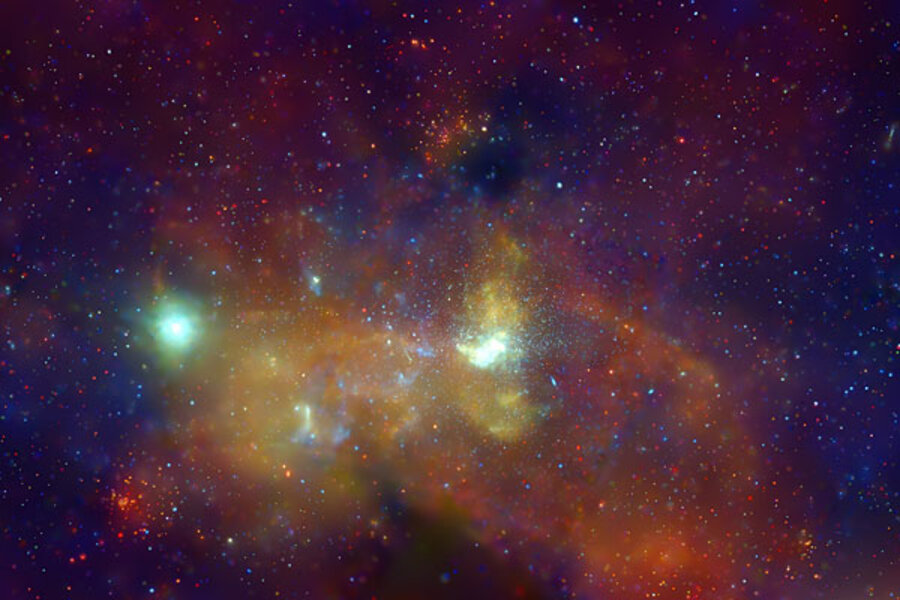Planets hurtling near the speed of light? It's possible, study says.
Loading...
Deep in the heart of the Milky Way, where a supermassive black hole lurks, conditions are so chaotic that planets – and perhaps life – can't form: Or can they?
A small team of astronomers suggests one way to answer the question, at least as it relates to planets: Monitor the Milky Way's rejects – stars that the galaxy's central black hole has kicked toward intergalactic space – for signs of planets.
Such planets – orbiting a star or traveling alone – so far are hypothetical. The center of the galaxy is so shrouded in dust that planet-hunting as it's practiced in our galactic neighborhood is futile.
But individual ejected stars, dubbed hypervelocity stars because they are ejected at such great speeds, are anything but hypothetical. The first stellar speedster was reported to be leaving the galaxy in 2005. Since then, the total has grown to at least 16 hypervelocity stars reported.
Hunting for more in the galaxy's halo, where they are most obvious, then monitoring them for the signature of a planet's transit across the star's face, would help settle the question of whether the center of the galaxy is hospitable for planet formation, explains Avi Loeb, an astronomer at the Harvard-Smithsonian Center for Astrophysics in Cambridge, Mass.
He is one of the co-authors of a paper set for publication in the Monthly Notices of the Royal Astronomical Society in Britain that looks at the ejection mechanism and how one might go about the hunt.
With planet-hunting efforts such as NASA's Kepler mission finding hundreds of confirmed planets, with at least 2,000 candidates waiting in the wings for confirmation, the notion that stars at the galactic center also host planets would seem reasonable.
But several factors could weigh against planet-making there, Dr. Loeb explains.
The broader region around the black hole is a hotbed of star formation. Stars are roughly a million times more densely packed there than the stars in the sun's neighborhood. At the galactic center, the stars that form generally are more massive than the sun, burn hotter, and flit about the galactic center at speeds of more than 2 million miles an hour, compared with roughly half a million miles an hour for the sun.
Under those cramped, turbulent conditions, it would be hard for a star's disk of dust and gas to hang together long enough to allow planets form.
Still some observations hint that planets might form close to the Milky Way's center.
For instance, researchers have noted intriguing flare-like events as material gets heated, compressed, then swallowed via the black hole's extraordinary gravitational tug. Evidence suggests that the material might not be a star but asteroids – planetary building blocks.
The thinking: A flare from a doomed sun-like star would happen about once every 10,000 years and last for months, noted a team of astronomers from the University of Leicester in Britain and the University of Amsterdam in the Netherlands last fall. But observers had detected daily flares that would last for a few hours.
Earlier this year, researchers discovered what they interpreted as a gas cloud falling into the black hole. One possible explanation: The cloud originally orbited a low-mass star, but got yanked free to feed the black hole. The presence of a gas cloud near the galactic core would also suggest that planetary building-blocks exist there.
But what would happen to planetary systems after a close encounter with a supermassive black hole?
Loeb and collegues considered planets orbiting binary stars at a distance of 2,000 Astronomical Units from the galaxy's central black hole – or about 2,000 times the distance from Earth to the sun. If the stars contained one or two Jupiter-scale planets each, gravitational interactions between the stars and the black hole could send one star and its offspring hurtling out of the galaxy.
The remaining star would be stripped of its planets, which also could be ejected. Under the right conditions, the team calculated, these starless planets could leave the galaxy at a speed a few percent of the speed of light. Meanwhile, the now-planetless star left behind would migrate closer to the black hole.
“Other than subatomic particles, I don't know of anything leaving our galaxy as fast” as the fastest runaway planets in the team's simulations, said Idan Ginsburg, a graduate student at Dartmouth College in Hanover, N.H., and the new paper's lead author, in a prepared statement.
For a planet to remain bound to an ejected star, it would have to be orbiting very close to the star, Loeb says. That also would significantly boost the chance that big, ground-based telescopes could spot the effect these planets would have on the star's light as they transit their sun.
If hypervelocity planets or planetary systems exist, and if they harbored life sentient enough to notice, “this ride would be quite exciting,” Loeb says.
A planet system would move slower than an unbound planet, but in principle it could still be in for the ride of its life, he adds. It could get swept up into the accelerating expansion of space itself, he speculates, eventually reaching velocities that from an Earth-bound vantage point would appear to approach the speed of light.







